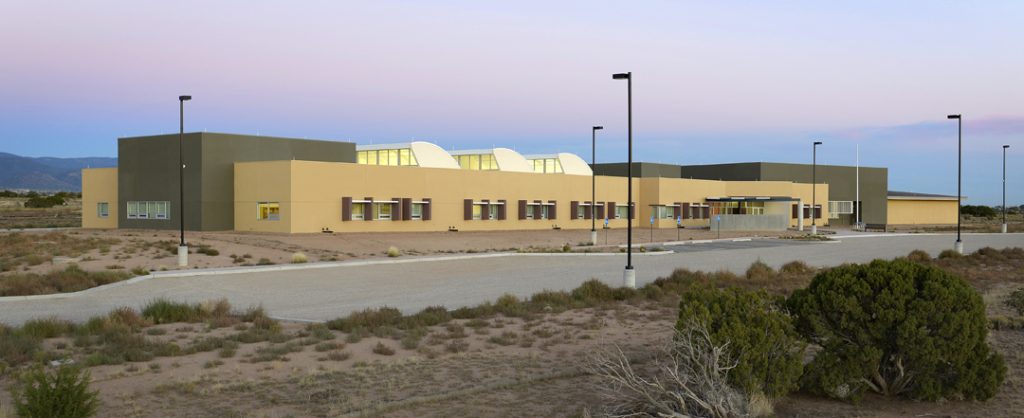The Center for New Mexico Archaeology (CNMA) is a central facility for archaeological research, curation, and education in the state of New Mexico.
The CNMA has created a safe and secure curation environment for New Mexico’s unique and irreplaceable archaeological heritage, including nearly 10 million artifacts from all time periods and cultures. The Archaeological Research Collection (ARC) is actively used for research and education. Growth (300-600 cubic feet per year) matches the pace of economic development in the state. Almost 50 percent of the collections are from federal or tribal lands, and the collections are managed by ARC on behalf of the client agencies.
The CNMA also houses the offices and labs of the OAS, which has provided not-for-profit cultural preservation services to state, federal, municipal, and private clients since 1952. Our highly qualified staff provides a full range of archaeological services.

Location
The CNMA is the initial development on a new 25-acre campus for museum collections and services. The campus is in Santa Fe County off of Caja del Rio Road, near the Santa Fe Animal Shelter. A lease-transfer agreement has been approved by the Bureau of Land Management, and the land has been patented to the state at the completion of construction. The campus will be the site of museum-collections care, conservation, exhibit fabrication, and education programs for the next 100 years. It will allow existing museums to focus their facility missions on exhibitions and public programs.
Constituencies
Ancestral Native American artifacts constitute the majority of the ARC collections, including sacred and ceremonial materials and human remains. In the past these materials have been stored under substandard conditions with inadequate consultation and visitation facilities. It is now possible to move spiritually significant archaeological materials from the Museum of Indian Arts and Culture to CNMA, decreasing tribal concerns over visiting and participating in MIAC programs.
ARC collections remain accessible to Indian religious leaders and artists who use the collections for the maintenance of cultural beliefs and practices. Native American representatives have been closely involved in the planning and design of the facility.
ARC works with dozens of agencies and tribes in cooperative collection management. ARC and OAS have collaborated to support federal agency responsibilities under the Native American Graves Protection and Repatriation Act. A special sensitive-materials area of CNMA has been designed with tribal consultants to respectfully hold collections awaiting tribal repatriation decisions.
Students and archaeologists from New Mexico and across the nation access ARC collections for research and training. Few archaeological sites are excavated for purely research purposes today, and previously excavated collections in ARC are regularly reexamined for new insights into the past.
The campus is being developed in collaboration with Santa Fe County. CNMA is compatible with existing land use along the Caja del Rio Road corridor. County roads through the campus will be the utility corridor for the Buckman Diversion water systems, and the campus will be a buffer and entrance for expected residential communities.
Archaeologists from throughout the state now have access to the expertise and specialty labs of the OAS, one of the oldest archaeological research organizations in the country. Animal bone identification, archaeomagnetic dating, plant-material identification, pottery analysis, and technology labs provide specialized services to clients and archaeologists throughout the Southwest. An architectural preservation laboratory will be reestablished in collaboration with the National Park Service, extending a program that was initiated in the 1980s.
The OAS education outreach program, Roads to the Past, has existed since 1991 and was recognized in 2005 with the Excellence in Public Education Award by the Society for American Archaeology. More than 65,000 adults and students have been served by the program, including Native American communities. A privately funded education center is planned for the campus, which will allow OAS staff to conduct teacher training in the social sciences as well math and science enrichment courses.
Planning History
The CNMA has been planned for nearly twenty years. Programming and schematic design for construction on the Museum Hill campus was undertaken in 1997. However, future expansion prospects were poor, and the development would have constrained the expansion potential of the existing museums.
Planning resumed in 2003 with a search for a suitable new campus. BLM land was available through the Federal Recreation and Public Purposes Act, and BLM has been supportive of the CNMA concept from the beginning. In 2004, land evaluation was begun, and both CNMA and the campus were programmed.
An architect’s contract was awarded in 2005, and a schematic design was developed for the campus and the building. Construction has achieved LEED Silver certification and accommodates phased growth over the next century. Due to the reality of incremental funding, the construction plans accommodate phased construction, if necessary. The ARC will be given priority, since existing storage space cannot accommodate more than a few years’ growth.
Construction of the campus infrastructure started with state funding in 2009. As money becomes available, subsequent construction phases will follow.
Funding History
Funding for CNMA began in 2005 with a $25,000 appropriation sponsored by Senator Shannon Robinson. Subsequent capital outlay appropriations in 2005, 2006, and 2008 raised the total to $5.95 million, toward a total estimated cost of $9.7 million. The additional funding was received from federal and private sources.
During the 2024 New Mexico legislative session, the New Mexico Senate approved an additional, special appropriation for the Center for New Mexico Archaeology for Fiscal Year 2025 in the amount of $140,000.